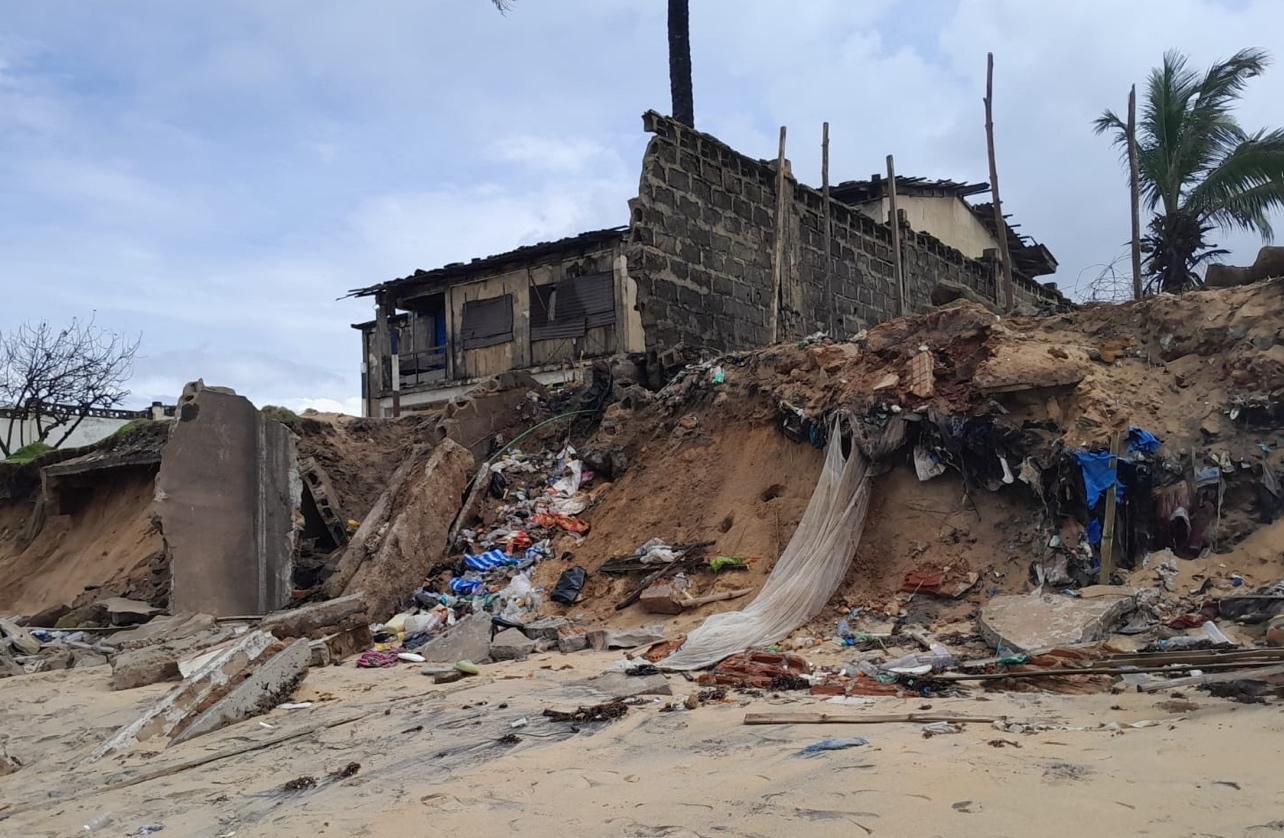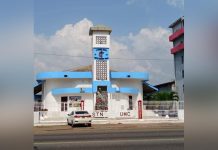Africa-Press – Liberia. Summary
Ocean surges destroy fences along Liberia’s Sinkor coastline, with UN projections warning that 230,000 Liberians face losing their homes to rising seas by 2100
Stark inequality emerges as former President George Weah’s residence stands protected by boulder barriers while neighboring properties are unprotected
Critical infrastructure is threatened, including Liberia’s only referral hospital,
SINKOR, Monrovia – Powerful ocean surges battered the Sinkor coastline over the weekend, destroying property fences and sending shockwaves through communities already grappling with Liberia’s escalating coastal erosion crisis.
While no houses were lost during the latest surge, the weekend’s events have amplified fears among residents who now face the stark reality that their properties stand directly in the path of an advancing Atlantic Ocean projected to claim 200 meters of shoreline by 2100.
Nancy Witherspoon, a six-year resident of 10th Street, watched helplessly as the ocean destroyed her fence for the second time.
“I am terrified,” Witherspoon said. “The condition here is very grave. The ocean is very threatening.”
Nancy Witherspoon, property is one of those at immediate risk of the surges. Credit: Joyclyn/New Narratives
Nancy is among those directly impacted by the surges. She has resorted to installing reed barriers to prevent intruders from accessing her property through gaps left by collapsed fencing.
According to United Nations Environment Program projections, an estimated 230,000 Liberians will lose their homes to rising seas by the end of the century at current levels of global warming. The coastline will retreat 190 meters inland, reaching towards Tubman Boulevard in Sinkor and swamping low lying areas along Liberia’s coast.
The Greater Monrovia area faces particularly severe threats. A predicted 16-centimeter sea level rise by 2030 would put 675,000 people and 9,500 hectares of land at risk in the metro area, which currently houses approximately 1.7 million residents.
“Right now, I am thinking how to get heavy truckloads of rocks to see if I can deposit them there to help keep the tide away from the property,” said Winston Browen, who has lived in the area for over ten years. He estimates his property here is valued at over $US200,000.
.The situation has exposed deep inequalities in Monrovia. Just a street away, former President George Weah’s 9th Street mansion is fortified with a mountain of boulders, shielding it from the same surges that batter neighboring properties.
“The rock is only protecting the former president’s residence,” said Browen. “Others are vulnerable because we don’t have protection. When the waves come, they just hit our fences and break them down.”
Boulders placed at the back of former president Weah’s fence to protect it from the surges. Credit: Joyclyn/New Narratives
Witherspoon recalled begging Weah’s staff for help during his presidency. “We thought he would consider us when he built that wall, but our cries fell on deaf ears,” she said.
Some structures that disappeared during recent surges were illegal constructions built in recent years in prohibited coastal zones, according to environmental experts.
Professor Jerome G.N. Nyenka, professor of Forest Economics, Carbon and Climate Change at the University of Liberia noted that “unregulated infrastructural development along the coast is more of a culprit” than other factors in accelerating erosion.
Nathaniel Blamo, a coastal management expert, emphasized that illegal settlements along the shoreline must be controlled through proper coastal zone management systems.
“Some coastal areas of Liberia are below sea level, and any little eruption to the ocean can cause the sweeping away of houses of people in the city of Monrovia,” he warned.
Residents consistently identify illegal sand mining as a major contributor to the erosion crisis. Clarence Kromah, who has lived in the area since 2019, described unprecedented destruction this year. “Every rainy season we have not experienced erosion like this,” he said, attributing the damage to “illegal mining of sand by some community dwellers.”
Witherspoon reported seeing “maybe 15 keke trucks pulling sand every day” from morning until midnight, despite multiple appeals to authorities, including the Environmental Protection Agency. “I wrote letters to the mayor, Jefferson Koijee,” she said. “He sent someone, they arrested one or two people, but that was the end. After that, more miners came. Some days, you could see 15 keke trucks pulling sand.”
A copy for the communication that was sent to Koijee. Credit: Joyclyn/New Narratives
Liberia’s Environmental Protection Agency admits the problem is dire. EPA Executive Director Dr. Emmanuel Urey Yarkpawolo told FrontPage Africa that the threat stretches “not only in Sinkor but the entire coastline of Monrovia and other coastal cities.” He added that the agency has drafted proposals but is still searching for funding.
Dr. Yarkpawolo acknowledged the agency’s awareness of coastal erosion threats “not only in Sinkor but the entire coastlines of Monrovia.” However, for areas like the Hotel Africa corridor, the agency has only “developed proposals and is seeking funding.”
“We are enforcing the Environmental Protection and Management Laws. Our inspectors are trying their best. But the main issue is the sea erosion,” Yarkpawolo stated.
While the EPA has implemented coastal defense projects in West Point through Green Climate Fund financing and similar initiatives in Sinoe County, residents in affected Sinkor areas report minimal government intervention.
The crisis threatens critical national infrastructure, including the John F. Kennedy Medical Center, Liberia’s only referral hospital, located between 18th and 24th Streets along the vulnerable coastal belt.
“Even JFK is under threat,” said coastal management specialist Nathaniel Blamo. “If the ocean breaches that area, it’s not just homes – it’s our entire health system at risk.”
Communities behind JFK are being washed out gradually, according to expert assessments. Already, 0.8 square kilometers of land have been lost in recent decades due to coastal erosion, impacting infrastructure and population centers across the Greater Monrovia area.
Affected residents are calling for immediate government intervention, including the installation of boulder barriers and enhanced security to prevent sand mining operations.
“I am calling on this government to please see how this can be stopped,” said Clarence Kromah. “The government should put at least rocks behind everybody’s fence, so we don’t experience this in the next rainy season.”
Clarence Kromah points at the damage to his fence. Credit: Joyclyn/New Narratives
Nancy Witherspoon issued a direct plea: “I pray every day for the government to help us. If nothing is done, one night the sea will take us – and many of us can’t even swim.”
As Liberia’s coastal communities brace for the coming rainy season, the weekend’s surge serves as a stark reminder of the accelerating climate crisis threatening to reshape the nation’s coastline and displace hundreds of thousands of its citizens.
For More News And Analysis About Liberia Follow Africa-Press






